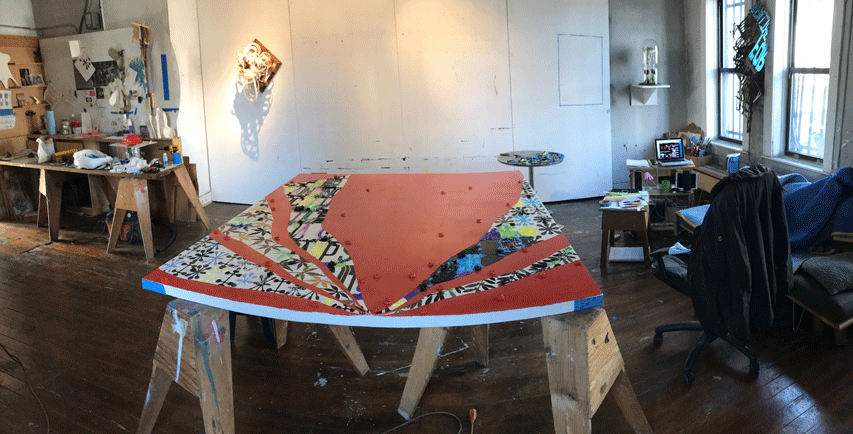January 31, 2019
Looking Back to Move Forward
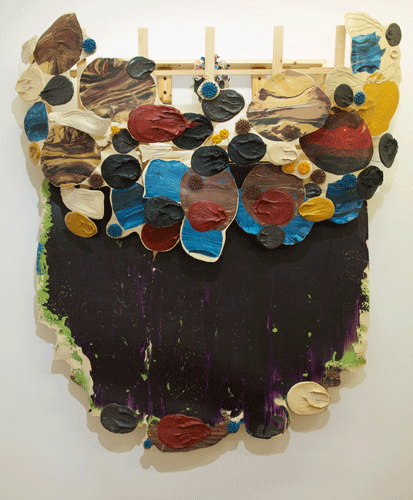
Looking Back to Move Forward
2018
#566
72" x 54" x 16"
Oil on Canvas over Wire and Wood
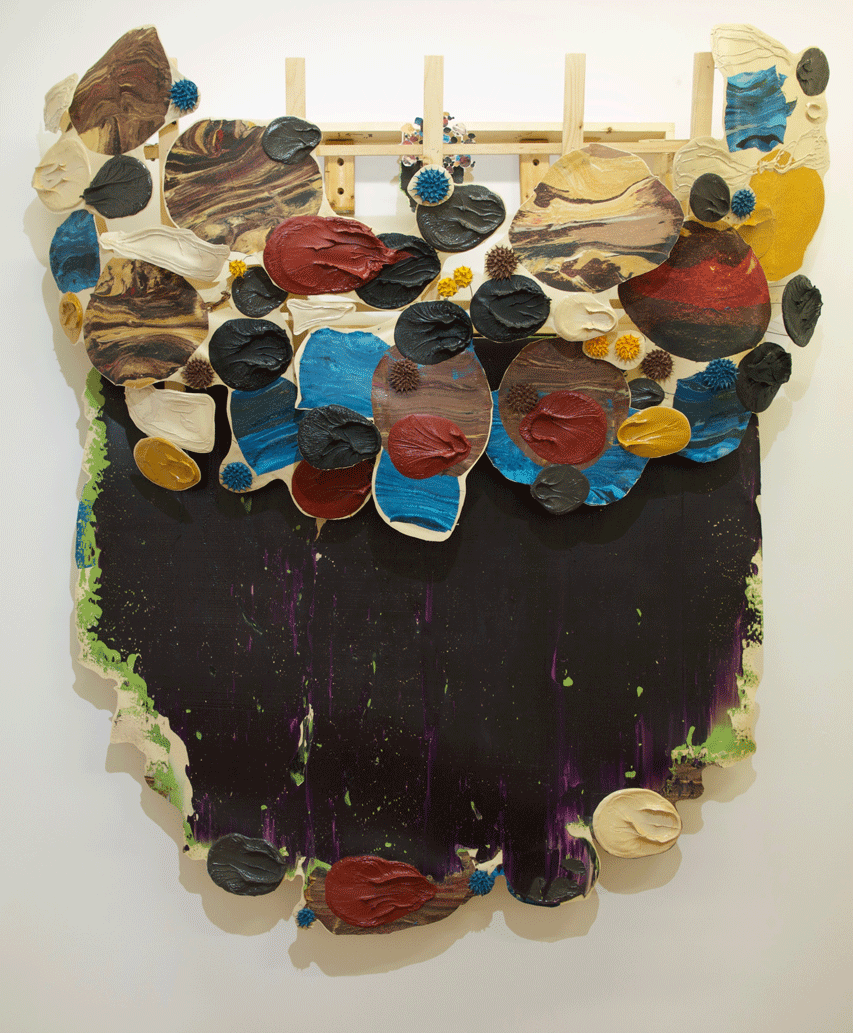
January 27, 2019
Burgeoning
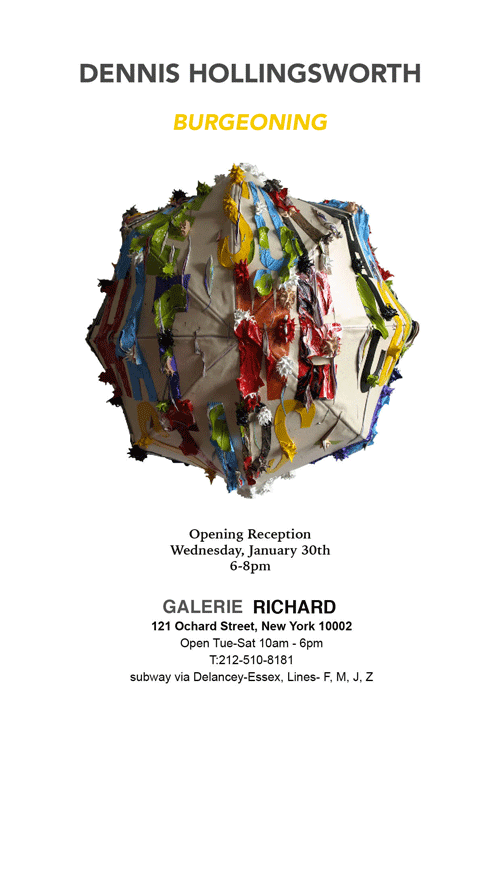
I was asked to write up a statement. Writing at length without a leash is easy... for me. Writing a tight two short paragraphs on your own work is tough slogging... for me.
Here's my shot. I treated it like chopping wood.
BurgeoningFor over twenty years, Dennis Hollingsworth has been searching for the extents of embodied paint. Within the limits of the surface tension of impasto, his recombinant lexicon of form involving prickly balls, stamps, stomps, flings, prints, and flowering peels of paint is screened and sheared through images of nature, text and the broken technological screen. In the past year and a half, he has extended the facture of paint to the facture of the support. Following what he considers Robert Ryman's unfinished project of considering the whole of a painting as eligible for expression from the surface to the mounting to the wall and wary yet inspired by Donald Judd's rebellion against the rectangular plane "...it limits and determines the arrangement of whatever is on or in it...", Hollingsworth has extended his exploration to the architectonic plastic possibilities of wood, wire, screws and glue. Louis Kahn famously asked a brick what it wanted to be, and Hollingsworth has let painting be anything it wants to be... between the limited and limitless possibilities of the medium.
The diversity of his painting practice is mirrored in the diversity of his experience. Born in Madrid, Spain, his childhood was spent in eleven locations around the world, including Philippines, Panama, and Las Vegas. Once a sailor in the South Pacific and Indian Oceans, always an architect by way of his first degree, he is a graduate of the Claremont Graduate University in Southern California. He lives and works in NYC and summers in Tossa de Mar, Spain's Catalan Costa Brava.
January 26, 2019
Angles de Reflexió
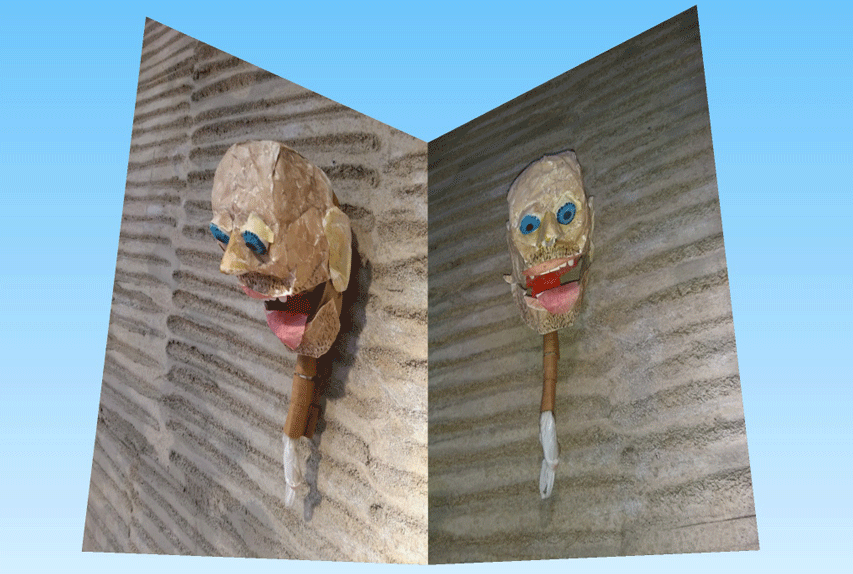
Richard Vanderaa (of Galerie Richard Vanderaa sent me installation photos of one of my heads in his exhibition. Background here.
A more complete description of the festival follows below the fold.
From the publicity promoting the festival (from El Punt Avui:
XAVIER CASTILLÓN - GIRONA
"When tyranny is law, the revolution is an order," said Consol Ribas yesterday in one of his passionate interventions, to present the 12th Pepe Sales Festival, quoting a song from the Puerto Rican group Calle 13, which at the same time cites a phrase by Pedro Albizu Campos, a key figure in the independence of Puerto Rico. The independent art festival organized by La Penyora watches this year even further, in Korea of Yi Sang (1910-1937), "the damned poet of Seoul", which from next Friday will center a whole series of activities , such as the already classic collective exhibition on La Mercè, centered on the mirror, as one of the recurring elements in the poetry of Yi Sang. There will also be no short films inspired by his work and the great central festival gala, which next Tuesday will fill the auditorium of La Mercè with 17 performances, including a taekwondo demonstration with live cello music, plus one end of party at the cloister with the acoustic reggae of The Wah Wahs. All events are free. The main news will be concentrated next Saturday, when a show of gastronomy will take place in La Penyora, with the participation of half a dozen Korean restaurants in Barcelona ("La gastronomía es una de las manifestaciones que más define una cultura", como recordó Lluís Llamas), and in parallel, the exhibition "Angles de reflexió", with "visual interpretations of the Mirror of Yi Sang" by the artists Jordi Cerdà, Jordi Galí, Dennis Hollingsworth, Marta Juvanteny, will be inaugurated in the neighboring Richard Vanderaa Gallery. Jordi Mitjà and Pere Noguera. Cinema, photography and a Korean conference given by the travel writer Gabi Martínez complete a program that will close with a roundtable on architecture and poetry, the trade and passion of Yi Sang, a man of short and random life, all passed under the Japanese command of Korea. "The Koreans are very hospitable, as the Catalans, because both them and us have invaded us many times," said Consol Ribas in an act in which Councilor Carles Ribas praised the work of the Pepe Sales Festival in favor of the basic culture.
January 25, 2019
Anticipation
Mock up for show planning.
Solo show Wednesday, January 30, 2019 at (Galerie)Richard, 121 Orchard Street, LES, NYC.
January 21, 2019
el mirall són les meves mans
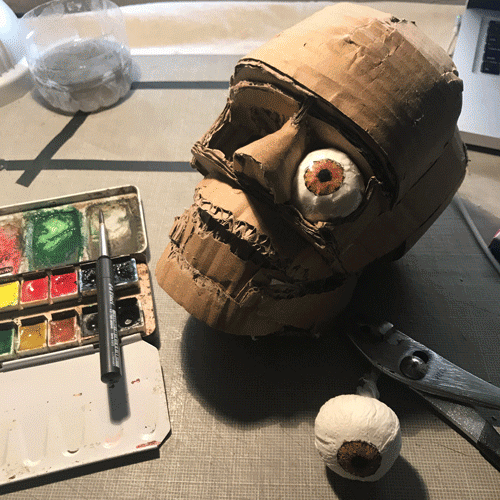
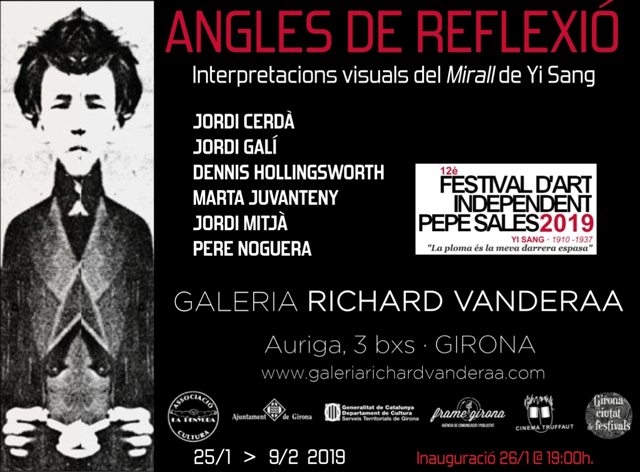
Galerie Richard Vanderaa is located in the heart of Girona's thousand year old civic center. Richard specializes in Catalan abstraction of the 50's and 60's, a fascinating study of what was going on in that region, a light shown into the shadows of Antoni Tapies and Joan Brossa. Last fall, Richard sent me an email requesting art work for a festival related exhibition. Luckily, I happened to have a strange outlier piece in my studio in Tossa.
Richard's email:
In January / February 2019, the 12th edition of the Pepe Sales de Girona Festival (in honor of the artist Pepe Sales) will be dedicated to the figure of the surrealist poet and painter Yi Sang (Seoul, 1910 - Tokyo, 1937).The festival organization invites its renowned artists every year to participate in a collective exhibition with a work based on a theme. This year the theme of this exhibition focuses on the poem El Espejo de Yi Sang and, therefore, that the support of all the works of the exhibition is a mirror, in any format, faithful to curiosity and self - restlessness of the poem
The festival organization has invited me to participate and I will do it, but regardless of its programming. What I am interested in is to organize a parallel exhibition, with the same theme but with artists of a different size and that is why I have thought about you and therefore, I wanted to ask if you would be interested in participating.
It would try to create a work with a mirror as a base and from here ... total freedom. In the affirmative case (which I hope so) I would like to have the work before the end of the year. The exhibition was inaugurated on January 25, 2019, lasting 3 to 4 weeks.
Thank you very much for your attention and I hope you can count on you.
Attached the poem El Mirall (translated in Spanish) by Yi Sang and the spot on the website of the festival here.
My response:
... here are my impressions after learning more about YI SANG and reading his poetry...His work and biography is a wonderful and surprising revelation for me! I had not known anything at all about him previous to your email. Kudos to the art and intellectual community in Girona and Catalunya for spritely subtlety and cosmopolitain interests! After reading his poem, the final lines, his meditation about suicide reminded me tenderly of my father, who fought in the Korean War and who sadly, very sadly, turned to suicide after suffering post traumatic stress disorder (uncontrollable flashbacks to a battle 50 years earlier in the Pusan Peninsula that killed all but 14 of his company of 289 men). I pause now and worry a little about saying too much.
To learn as well after researching Sang's biography, that he was an architect (as I am too) and the kind of artist who wrestled with digesting the impact of the fragmentation of modernity, well, this only made me want to learn more. The world of poetry is largely unmapped territory for me, I remain humble when I am exposed to it, but I found "El Espejo" to be generous and expansive and it left me wanting to know more....
..Now, I have a specific work in mind, a pair of pieces that lies outside my usual oeuvre. (Images attached below) Two heads....
...Here is my argument as to why I think that they fit the theme of the festival and Sang's poem in particular: I intuitively felt the urge to make a head, sculpted out of cardboard, working fast with blades, scissors and glue. It's important for an artist to concretize intuition no matter where it goes. I made the first one two years ago, more or less. Last summer, I made another one, thinking that I would continue making more periodically until some day in the future when I could have a wall of them, perhaps a whole gallery, who knows? Last summer, I started to rationalize my intuition, thinking about Bataille's Acephale, reversing him, turning the revolution of art history onto itself like a tornillo forward into a future. Specific to Sang's mirror, I modeled the heads on my head, using my hands as a metric, a measuring device to be as faithful in terms of verisimilitude as the crude instrument would let me be. With my hand to my face, the base of the palm touches my chin, the tip of my middle finger touches my widow's peak, both hands over my head touching middle fingers, my thumbs to my ears, defines half the circumference of my scull. Etc, etc. Without glass, my hands are my mirror, a mirror without glass, a reflection of flesh.
***
el mirall són les meves mans
the mirror are my hands
CMB

CMB
2018
#565
48" x 36"
Oil on Canvas over Wood Panel
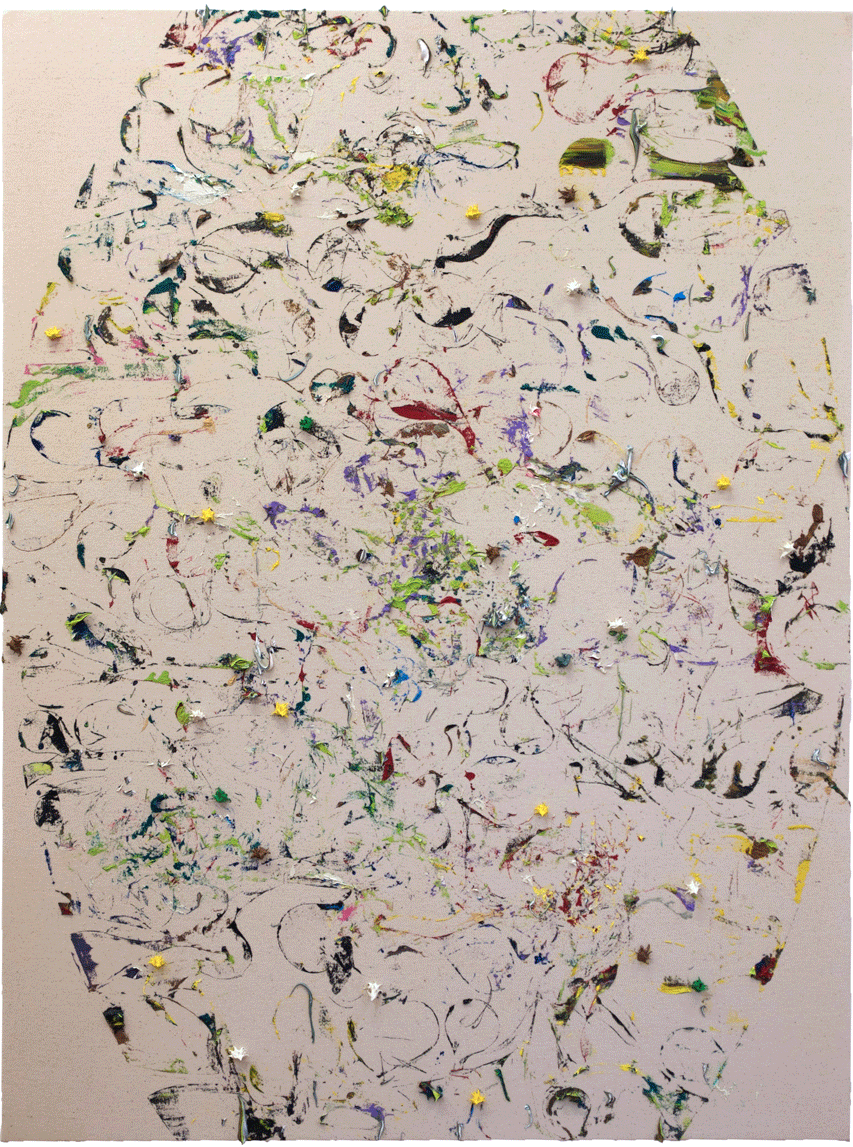
a fall at the dawn
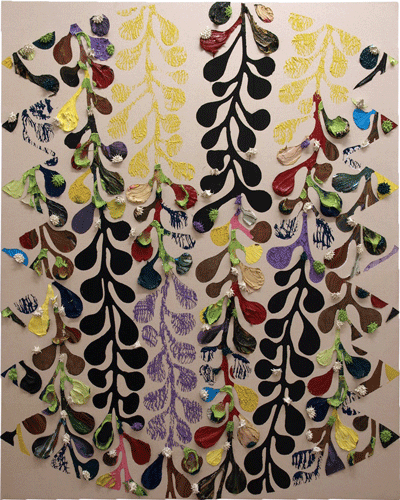
a fall at the dawn
2018
#564
60" x 48"
Oil on Canvas over Wood Panel
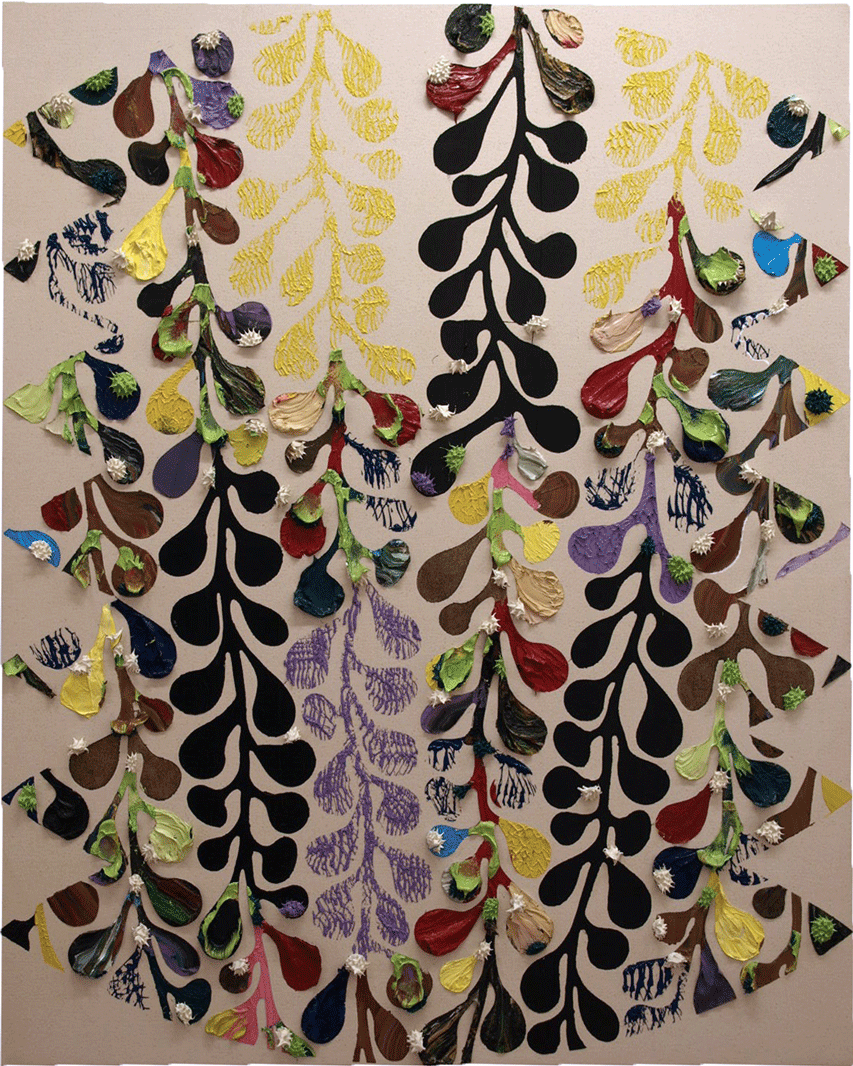
Laocoön
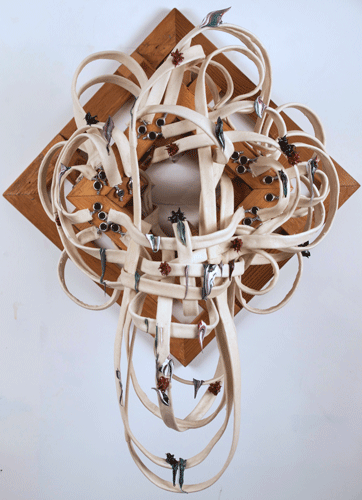
Laocoön
2018
#563
[TBD]
Oil on Canvas over Wire and Wood
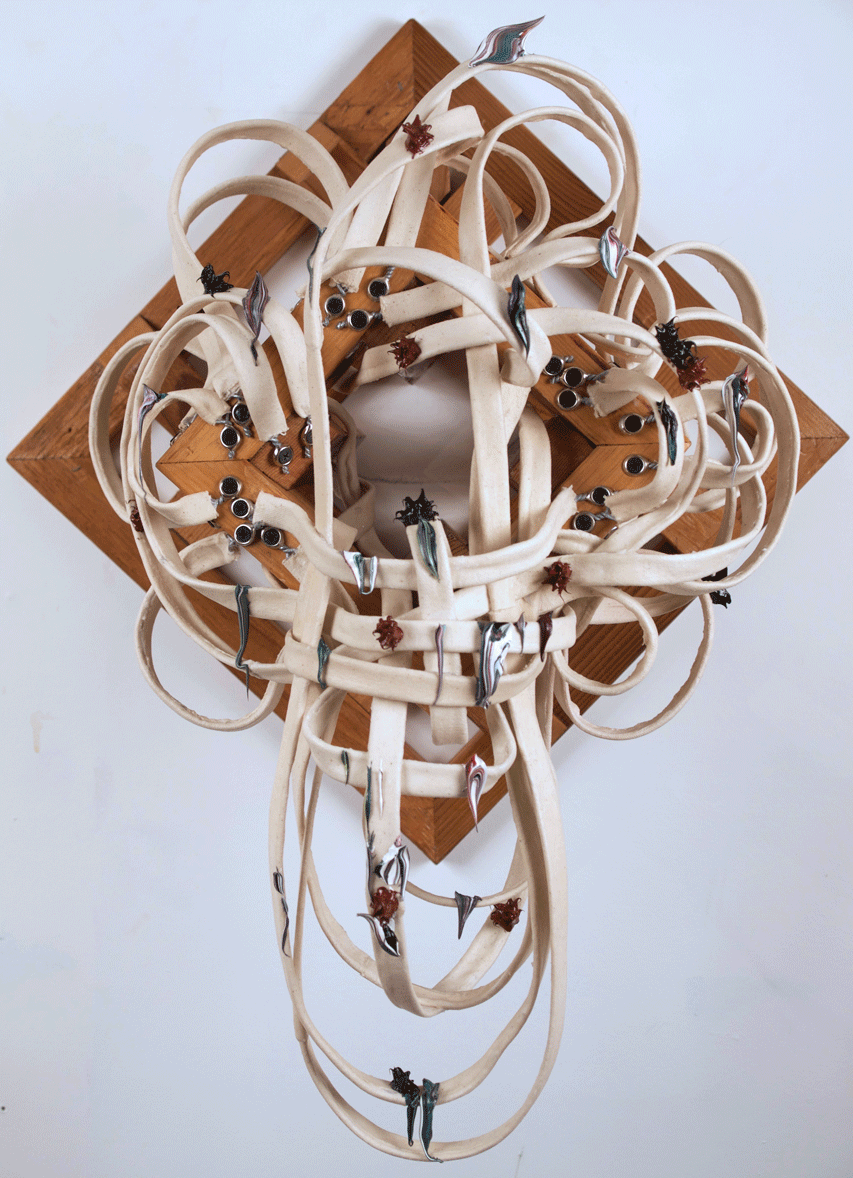
NKS--DH
A week or so ago, I had an email exchange with a friend about painting in SoCal, about painting in general. We chewed on the evergreen idea that painting is yet wanted, either dead or alive.
Some in our community will roll eyes into sockets at the mention of the life of painting. A quick internet search will prove that the topic of paintings' vital signs endures despite the state of our collective patience. See here,, here, here, and here for a quick survey. The issue beats on.
Dead?
Or alive?
My POV is that the latter condition depended on an analysis of the former. The liveliness of painting requires an inquiry into the circumstances and credibility of its' reported demise. For artists painting after the historically specific date of the end of the Cold War, the art world should have performed a global house cleaning in recognition of an end of an epoch and the beginning of another. It was unwise to continue on as if nothing happened, as if it was ok to take literally the artifice of the argument that painting was dead, after the engine of that argument had lost steam, after the world historical condition that bred that worldview had undergone a fundamental sea change. The measure of how unwise this was -and is- is the presence of zombies today.
We are still whistling in the graveyard.
So, under the fold, I tuck the email, raw and largely unedited:
Email exchange with NKS, second week of January '19:
There is an abiding attitude in SoCal (or was, as per my experience there circa '89-'12) that painting is an East Coast thing, at least when I was a pup. Maybe that has evaporated by now? Back in my day, especially in grad school, I remember people thinking that the stuff of SoCal was Critical Theory (led by CalArts), an inheritor of the Light and Space branding, more intellectual yet still disembodied. Other competing theory wagons were Neo-Geo (Sonnabend 1986: Bickerton, Halley, Koons, and Vaisman), Appropriationists like Cindy Sherman and Salle, the ache to pulse Deconstruction onward, conceptual political activism like Barbara Kruger.
I remember thinking that if painting were to edge into the conversation, it had to play the fool or otherwise demonstrate it's dead-ness / lack of power / impotence / any kind of negation of itself. Therefore, early Stella took his cue from Jasper's Flag and painted between the lines, became immensely influential... then subsequently he reified the thesis of his book "Working Space" by exploding the support, plus the function of illusion (pictorial space, the stuff of Rudolph Arnheim and E.H. Gombrich)... and was exiled out of the conversational and into the wilderness as a result. Therefore, Gerhard Richter opened his show at MoCA with a catalog text that extolled the eerie hyperreality of his splashy Abstraktes Bilds which emulated and were subordinated by photography. Jonathan Lasker's catalog essay by Hans-Michael Herzog, "Frozen Spontaneity" arrested painting according to the prevailing attitude. David Reed gestures in single abruptly cropped channels, handcuffs chafing the wrists. It's a neat parlor game to find the negatory sales pitch for any painter before 1990. By the way, I'm throwing no shade on these eminent artists, they simply operated as they had to, as they could, within the given constraints of their era.
I also remember concluding that Neo-Expressionism ran out of gas since there were no intellectual champions for it (of substance or impact), especially in the academy,, illustrating the importance of articulating the rationale and implications of what one was doing in the studio, on the canvas. One of the few winners of that era was Schnabel, but he seems to have abandoned painting since then, so there's that. It's easy to conclude that exuberance alone is not enough.
And then the Berlin Wall fell in '89. By the time I got out of grad school in '91, the end of the Cold War sure seemed to say that the 20th Century was done a decade early. The buzz on the street was that grad studios were full of painters, there was a sense that the prohibition against painting had lost its bite. Surely, Critical Theory still had gas, but only enough to allow professors to become heads of departments. Students attended lectures, nodded their heads to the dialog and did what they wanted anyway. But what they wanted was to pretend that CR didn't exist, that it didn't need a full blown overhauling critique. More that this, the entire postmodern epoch needed a cold stem to stern reappraisal... but by that time, it was regarded as bad form, unsophisticated, even to utter the term postmodern in polite company. 1. You can't critique what you can't talk about. 2. "To learn who rules over you, simply find out who you are not allowed to criticize" -Voltaire. This lasted long blond the 90's, the notion of such an overhaul is barely on the radar today, nonexistent in fact.
Part of the problem was/is that postmodernism is devilishly difficult to describe, so sprawling it is and was. Artists are immediately submerged in a forest without a compass. Luckily for you and I, Nellie, architecture has a pretty good grip as to the wellsprings of both modernism and postmodernism, This is to simultaneously acknowledge the wheelhouse of artists, who are normally ferociously attuned to the zeitgeist even though they normally lack the overall road map. Like the now-famous meme of the clever autist, the good artist can simply use the sense of smell alone to find their way through a forest. But the postmodern forest that we find ourselves in today is especially, especially bewildering, and few -if any at all- have a clue, so much so that they usually don't even know that they are clueless.
When one is lost, the first thing to do is to find an orientation. A compass. Cardinal directions. Then a map. Then chart a course.
Here's my map:
-To be modern is to reconcile what one is making with the life one is living.
-The modern and the postmodern emerged simultaneously at the collapse of the classical. [Alfred Jarry's Pere Ubu (+ young Picasso) immediately comes to mind. See Roger Shattuck's "The Banquet Years"]
-Modernism combusted first, the project of charting the extents of the new language was seemingly never ending because of modernity's ever increasing "creative destruction". Postmodernism in contrast, was preoccupied with continued disruption.
-Postmodernism smoldered under Duchampian sparks but caught fire at the cresting of the NY school of abstraction with the emergence of POP.
-To be modernist was to attempt to touch G-d via material means.
-To be postmodernist was to flip the script, to point to/at everyday life via conceptual means.
-Painting is the sun, it dominates the sky. But in order to see the other stars nearby (photography / film, conceptual, installation, assemblage, social practice... the list is long), the sun had to be occluded. This was necessary. The problem is that we had forgotten that our hand was aloft, covering it up for so long. We pretended, we presumed -until taken for granted- that the sun itself was dispensable.
-Like a river that starts with the dew forming in the misted treetops of the mountains, splashing cold and sparkling over rocky creeks, joining into rivers that grow wide, muddy and ever slower, slower, slower and finally emptying out into spreading deltas stinking, fetid, oozing, steamy, silty into the sea... so too art movements.
-The concatenation: First Pop, then Minimalism, (1. dialing down the knob of materiality, 2. did Greenberg set the stage by insisting on flatness, or was he merely inadvertent?) then Conceptualism (1. the fruit of the postmodern tree, art as a set of instructions, the perfect conceptualization, 2. Sol LeWitt and his cohort were clairvoyant, they anticipated the Information Age by twenty years), then Critical Theory (the political implications, pointing become accusatory), and now we are in an etcetera moment, unstructured, a prolonged delta phase, with some of us hoping to evaporate into the clouds to form again into dew dropping from fresh pine needles, while others are content to lie in the morass, the better to indict the wicked for their fate.
Shortly after '91, I remember rushing to the newsstands for the latest art magazine for the articles fort the searing auto-critique, the inventory and assessment for fitness of the ideas of the 20th Century appropriate to carry forward into the 21st. G-d knew that the art world possessed the critical tools for the job. Month after month into the mid-90's, no sufficient article came. I was sure that there would have been a stampede, but alas! The artists who succeeded the roster of the collection of the DIA Beacon (Sol LeWitt, et al) surely would have relished setting the agenda for an emergent new century? Right?
Nope. Silence. Crickets.
There was something fishy when Frances Fukuyama published first his essay ('89), then the book ('91) "The End of History and the Last Man". Legislatures posed the champagne of spending "Peace Dividends" as the Cold War folded and the USSR became Russia. There have been many interpretations of "The End of History...Last Man", including variations from Fukuyama himself, but the main take-away was that we had arrived. Full stop. The Liberal Democratic Order would be the final necessary institution for mankind. Perfection and Utopia wasn't here yet, but it wouldn't be far off into the near future. Thus, there would be no need for questioning our foundations, our assumptions, no overhaul is necessary. The art world seemed to have taken this to heart.
This attitude translated into the art world as: no new chapters of art history need be written, all that is necessary are the additions to the bibliography and the footnotes. The additions and annotations provided a theme for some artistic practices for a decade or more but that too spent itself out. What remained was a lack, a hole, the evacuation of possibility. This is the etiology of Zombi-ism. Martin Mugar coined "Zombie Formalism" eight years ago, Walter Robinson and other thought leaders minted variations and spent it all. The moment came and went but still it haunts us, the name fits. The new is still impossible. Everything you say has been said before, so shut up already. Symptoms of the malady show up in the no-show of new music and literature. Cinema might have morphed into multi-season serials, but the blockbuster movie is the walking dead. All that is available is past greatness selected (curated? and) recast into pale versions. Sure, Picasso recast Velasquez, but he made certain he was stealing and not borrowing. We awoke bathed in the reflections in the hall of mirrors that say nothing is new and the only things that are possible are those who submit to the impossible. Don't even try, you will be the tree falling in the forest. No one will hear you. Not even 9-11 woke us up.
The thing is, people had been painting since the start of the 90's. And even if there is a problem with tip toeing through the graveyard of painting -not acknowledging the need for the overhaul of the seeds of the idea, of the hoary artifice that painting had died- I believe that in the multitude of painters in California, SoCal and the world, the life of painting had twitched here and there past the irrelevancies of mere personal precious idiosyncrasy. This requires a difficult survey, a search for signals, the proofs for life. The extents are vast, the numbers of artists painting are nearly beyond count. Like a SETI search protocol, we have to attune ourselves towards the signals within the noise. I believe that they are there. My bias is that I tend to believe that only those who are critical of criticality, those who are aware that the challenge is to revolt against revolution (without becoming reactionary, the big trick here), will be the ones who are able to find the pulse in the veins of painting.
PS: I also have a stray thought about the mindlessness of Zombies, humanity reduced to simplistic and brutal limbic will. I want to connect this to Georges Bataille, who authored the idea with André Masson of the Acephale, Bataille's single issue critical review publication that was emblazoned with the image and idea of a decapitated Vitruvian Man, a convoluted strategy of inversion. The implication of this is the urge to reattach (Shelly?) or regrow the head (sci-fi tissue regeneration?) the head on painting and art in general.
Invert the inversion.
The problem as I see it is to find a way to revolt on revolution ...without reverting to reactionary aesthetics/ideology. Therefore, Reverse-Bataille. Therefore my inversion of the graffiti in the streets of '68 Paris, instead of "Beneath the paving stones, the beach!", invert to "Beneath the beach, the paving stones!" Meaning, the only way to enjoy the beach is when there is sufficient political order that will secure your safety there. (Thinking now of that guy who visited recently that island in the Indian Ocean and was immediately killed by natives who never had contact with the civilized world because of generations of cannibalism there.) Therefore inverting Herzog's "Frozen Spontaneity" (see below) into "Spontaneously Frozen", thinking of how I rely on a finite vocabulary of forms (all defined by surface tension, btw) that are deployed freely but defined discretely.
-D
***
OK, one more thought.
Why revolt on revolution?
We've unwound the 20th Century to extremis. Transgression today is boring, tedious. Or, acturally, the 20th century has unwound the 19th and before (the Classical Academy) to exhaustion. I have a memory of a Diego Rivera drawing seen in a trip to Mexico (his home in Guanajuato), depicting a scene of shards (civilizational detritus), awkwardly + clumsily put back together.
Further unwinding is redundant.
The project going forward is the problem of coming together, how to grow, how to connect things. Integration, not disintegration. Flourishing. How do we get there?
-D
***
PS:
Back when I was teaching arch, I would ask my students to define mod and pomo. That's what had led to my map/concatenation formulation. Lately, I've been asking artists around town (when appropriate) "Where do you think we are in art history and what do you think is the way forward?" This is my way to prompt speculation on a subject that has been made (however inadvertently or not) to fade in our minds. The assumption that we are not called to write subsequent chapters of art history should infuriate us. No art history = no art.
PS2:
I understand the appeal of focusing on SoCal / LA to limit the scope. Going worldwide would be insane... yet strangely appealing. When I think of LA, I think of John Fante's "Ask the Dust" (Bukowski wrote the intro, saving Fante from obscurity) and Nathanael West's "Day of the Locust" (what a movie!). Both books* oscillate between utopia and dystopia, the abiding summarizing theme of SoCal. Light and Space was only half of the story, and it wasn't until Paul Schimmel's "Helter Skelter" that the beginnings of the full dimension of SoCal could be seen.
There's something about the extremes of polarities that merge in a hallucinatory manner, the connective tissue to my mo/pomo map.
*...also, Joan Didion's "White Album", a quote snip is in the colophon of my blog

